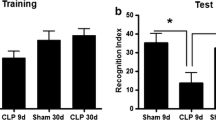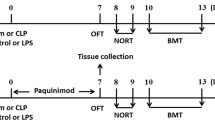Abstract
Sepsis-associated encephalopathy (SAE) is a potentially irreversible acute cognitive dysfunction with unclear mechanism. Striatal-enriched protein tyrosine phosphatase (STEP) is a brain-specific phosphatase which normally opposes synaptic strengthening by regulating key signaling molecules involved in synaptic plasticity and neuronal function. Thus, we hypothesized that abnormal STEP signaling pathway was involved in sepsis-induced cognitive impairment evoked by lipopolysaccharides (LPS) injection. The levels of STEP, phosphorylation of GluN2B (pGluN2B), the kinases extracellular signal-regulated kinase 1/2 (pERK), cAMP-response element binding protein (CREB), synaptophysin, brain derived neurotrophic factor (BDNF), and post-synaptic density protein 95 (PSD95) in the hippocampus, prefrontal cortex, and striatum were determined at the indicated time points. In the present study, we found that STEP levels were significantly increased in the hippocampus, prefrontal cortex, and striatum following LPS injection, which might resulted from the disruption of the ubiquitin–proteasome system. Notably, a STEP inhibitor TC-2153 treatment alleviated sepsis-induced memory impairment by increasing phosphorylation of GluN2B and ERK1/2, CREB/BDNF, and PSD95. In summary, our results support the key role of STEP in sepsis-induced memory impairment in a mouse model of SAE, whereas inhibition of STEP may provide a novel therapeutic approach for this disorder and possible other neurodegenerative diseases.








Similar content being viewed by others
References
Weberpals M, Hermes M, Hermann S, Kummer MP, Terwel D, Semmler A, Berger M, Schafers M, Heneka MT (2009) NOS2 gene deficiency protects from sepsis-induced long-term cognitive deficits. J Neurosci 29:14177–14184
Gofton TE, Young GB (2012) Sepsis-associated encephalopathy. Nat Rev Neurol 8:557–566
Sun W, Pei L, Liang Z (2017) mRNA and long non-coding RNA expression profiles in rats reveal inflammatory features in sepsis-associated encephalopathy. Neurochem Res 42:3199–3219
Boulanger LMLP, Raghunathan A, During MJ, Wahle P, Naegele JR (1995) Cellular and molecular characterization of a brain-enriched protein tyrosine phosphatase. J Neurosci 15:1532–1544
Xu J, Kurup P, Bartos JA, Patriarchi T, Hell JW, Lombroso PJ (2012) Striatal-enriched protein-tyrosine phosphatase (STEP) regulates pyk2 kinase activity. J Biol Chem 287:20942–20956
Paul S, Nairn AC, Wang P, Lombroso PJ (2002) NMDA-mediated activation of the tyrosine phosphatase STEP regulates the duration of ERK signaling. Nat Neurosci 6:34–42
Paul S, Olausson P, Venkitaramani DV, Ruchkina I, Moran TD, Tronson N, Mills E, Hakim S, Salter MW, Taylor JR, Lombroso PJ (2007) The striatal-enriched protein tyrosine phosphatase gates long-term potentiation and fear memory in the lateral amygdala. Biol Psychiatry 61:1049–1061
Zhang Y, Kurup P, Xu J, Carty N, Fernandez SM, Nygaard HB, Pittenger C, Greengard P, Strittmatter SM, Nairn AC, Lombroso PJ (2010) Genetic reduction of striatal-enriched tyrosine phosphatase (STEP) reverses cognitive and cellular deficits in an Alzheimer’s disease mouse model. Proc Natl Acad Sci USA 107:19014–19019
Hicklin TR, Wu PH, Radcliffe RA, Freund RK, Goebel-Goody SM, Correa PR, Proctor WR, Lombroso PJ, Browning MD (2011) Alcohol inhibition of the NMDA receptor function, long-term potentiation, and fear learning requires striatal-enriched protein tyrosine phosphatase. Proc Natl Acad Sci USA 108:6650–6655
Kulikova EA, Khotskin NV, Illarionova NB, Sorokin IE, Bazhenova EY, Kondaurova EM, Volcho KP, Khomenko TM, Salakhutdinov NF, Ponimaskin E, Naumenko VS, Kulikov AV (2018) Inhibitor of striatal-enriched protein tyrosine phosphatase, 8-(trifluoromethyl)-1,2,3,4,5-benzopentathiepin-6-Amine hydrochloride (TC-2153), produces antidepressant-like effect and decreases functional activity and protein level of 5-HT2A receptor in the brain. Neuroscience 394:220–231
Olausson P, Venkitaramani DV, Moran TD, Salter MW, Taylor JR, Lombroso PJ (2012) The tyrosine phosphatase STEP constrains amygdala-dependent memory formation and neuroplasticity. Neuroscience 225:1–8
Lisman J, Cooper K, Sehgal M, Silva AJ (2018) Memory formation depends on both synapse-specific modifications of synaptic strength and cell-specific increases in excitability. Nat Neurosci 21:309–314
Xu J, Hartley BJ, Kurup P, Phillips A, Topol A, Xu M, Ononenyi C, Foscue E, Ho SM, Baguley TD, Carty N, Barros CS, Muller U, Gupta S, Gochman P, Rapoport J, Ellman JA, Pittenger C, Aronow B, Nairn AC, Nestor MW, Lombroso PJ, Brennand KJ (2016) Inhibition of STEP61 ameliorates deficits in mouse and hiPSC-based schizophrenia models. Mol Psychiatry 23:271–281
Ji M-h, Wang Z-y, Sun X-r, Tang H, Zhang H, Jia M, Qiu L-l, Zhang G-f, Peng YG, Yang J-j (2016) Repeated neonatal sevoflurane exposure-induced developmental delays of parvalbumin interneurons and cognitive impairments are reversed by environmental enrichment. Mol Neurobiol 54:3759–3770
Begenisic T, Baroncelli L, Sansevero G, Milanese M, Bonifacino T, Bonanno G, Cioni G, Maffei L, Sale A (2014) Fluoxetine in adulthood normalizes GABA release and rescues hippocampal synaptic plasticity and spatial memory in a mouse model of Down syndrome. Neurobiol Dis 63:12–19
Saavedra A, Puigdellivol M, Tyebji S, Kurup P, Xu J, Gines S, Alberch J, Lombroso PJ, Perez-Navarro E (2016) BDNF induces striatal-enriched protein tyrosine phosphatase 61 degradation through the proteasome. Mol Neurobiol 53:4261–4273
Khosla C, Xu J, Chatterjee M, Baguley TD, Brouillette J, Kurup P, Ghosh D, Kanyo J, Zhang Y, Seyb K, Ononenyi C, Foscue E, Anderson GM, Gresack J, Cuny GD, Glicksman MA, Greengard P, Lam TT, Tautz L, Nairn AC, Ellman JA, Lombroso PJ (2014) Inhibitor of the tyrosine phosphatase STEP reverses cognitive deficits in a mouse model of Alzheimer’s Disease. PLoS Biol 12:e1001923
Thabit S, El Sayed NSE (2018) Effect of pioglitazone and simvastatin in lipopolysaccharide-induced amyloidogenesis and cognitive impairment in mice. Behav Pharmacol 30:5–15
Czerniawski J, Miyashita T, Lewandowski G, Guzowski JF (2015) Systemic lipopolysaccharide administration impairs retrieval of context-object discrimination, but not spatial, memory: evidence for selective disruption of specific hippocampus-dependent memory functions during acute neuroinflammation. Brain Behav Immun 44:159–166
Carty NC, Xu J, Kurup P, Brouillette J, Goebel-Goody SM, Austin DR, Yuan P, Chen G, Correa PR, Haroutunian V, Pittenger C, Lombroso PJ (2012) The tyrosine phosphatase STEP: implications in schizophrenia and the molecular mechanism underlying antipsychotic medications. Transl Psychiatry 2:e137
Jang SS, Royston SE, Lee G, Wang S, Chung HJ (2016) Seizure-induced regulations of Amyloid-beta, STEP61, and STEP61 substrates involved in hippocampal synaptic plasticity. Neural Plast 2016:2123748
Kurup P, Zhang Y, Xu J, Venkitaramani DV, Haroutunian V, Greengard P, Nairn AC, Lombroso PJ (2010) Abeta-mediated NMDA receptor endocytosis in Alzheimer’s Disease involves ubiquitination of the tyrosine phosphatase STEP61. J Neurosci 30:5948–5957
Lombroso PJ, Ogren M, Kurup P, Nairn AC (2016) Molecular underpinnings of neurodegenerative disorders: striatal-enriched protein tyrosine phosphatase signaling and synaptic plasticity. F1000Res 5:F1000
Goebel-Goody SM, Baum M, Paspalas CD, Fernandez SM, Carty NC, Kurup P, Lombroso PJ (2012) Therapeutic implications for striatal-enriched protein tyrosine phosphatase (STEP) in neuropsychiatric disorders. Pharmacol Rev 64:65–87
Czerniawski J, Guzowski JF (2014) Acute neuroinflammation impairs context discrimination memory and disrupts pattern separation processes in hippocampus. J Neurosci 34:12470–12480
Zhang JC, Yao W, Dong C, Yang C, Ren Q, Ma M, Han M, Wu J, Ushida Y, Suganuma H, Hashimoto K (2017) Prophylactic effects of sulforaphane on depression-like behavior and dendritic changes in mice after inflammation. J Nutr Biochem 39:134–144
Dong C, Tian Z, Zhang K, Chang L, Qu Y, Pu Y, Ren Q, Fujita Y, Ohgi Y, Futamura T, Hashimoto K (2019) Increased BDNF-TrkB signaling in the nucleus accumbens plays a role in the risk for psychosis after cannabis exposure during adolescence. Pharmacol Biochem Behav 177:61–68
Wu J, Dong L, Zhang M, Jia M, Zhang G, Qiu L, Ji M, Yang J (2013) Class I histone deacetylase inhibitor valproic acid reverses cognitive deficits in a mouse model of septic encephalopathy. Neurochem Res 38:2440–2449
Cases S, Saavedra A, Tyebji S, Giralt A, Alberch J, Pérez-Navarro E (2018) Age-related changes in striatal-enriched protein tyrosine phosphatase levels: regulation by BDNF. Mol Cell Neurosci 86:41–49
Xu J, Kurup P, Azkona G, Baguley TD, Saavedra A, Nairn AC, Ellman JA, Perez-Navarro E, Lombroso PJ (2016) Down-regulation of BDNF in cell and animal models increases striatal-enriched protein tyrosine phosphatase 61 (STEP61) levels. J Neurochem 136:285–294
Xu J, Kurup P, Baguley TD, Foscue E, Ellman JA, Nairn AC, Lombroso PJ (2015) Inhibition of the tyrosine phosphatase STEP61 restores BDNF expression and reverses motor and cognitive deficits in phencyclidine-treated mice. Cell Mol Life Sci 73:1503–1514
Ma M, Ren Q, Yang C, Zhang JC, Yao W, Dong C, Ohgi Y, Futamura T, Hashimoto K (2017) Antidepressant effects of combination of brexpiprazole and fluoxetine on depression-like behavior and dendritic changes in mice after inflammation. Psychopharmacology 234:525–533
Kim E, Sheng M (2004) PDZ domain proteins of synapses. Nat Rev Neurosci 5:771–781
Moraes CA, Santos G, de Sampaio e Spohr TC, D’Avila JC, Lima FR, Benjamim CF, Bozza FA, Gomes FC (2015) Activated microglia-induced deficits in excitatory synapses through IL-1beta: implications for cognitive impairment in sepsis. Mol Neurobiol 52:653–663
Xu J, Kurup P, Nairn AC, Lombroso PJ (2018) Synaptic NMDA receptor activation induces ubiquitination and degradation of STEP61. Mol Neurobiol 55:3096–3111
Saavedra A, Ballesteros JJ, Tyebji S, Martinez-Torres S, Blazquez G, Lopez-Hidalgo R, Azkona G, Alberch J, Martin ED, Perez-Navarro E (2018) Proteolytic degradation of hippocampal STEP61 in LTP and learning. Mol Neurobiol 56:1475–1487
Kurup PK, Xu J, Videira RA, Ononenyi C, Baltazar G, Lombroso PJ, Nairn AC (2015) STEP61 is a substrate of the E3 ligase parkin and is upregulated in Parkinson’s disease. Proc Natl Acad Sci USA 112:1202–1207
Liang L, Peng Y, Zhang J, Zhang Y, Roy Mridul, Han X, Xiao X, Sun S, Liu H, Nie L, Kuang Y, Zhu Z, Deng J, Xia Y, Sankaran Vijay G, Hillyer Christopher D, Mohandas Narla, Ye M, An X, Liu J (2019) Deubiquitylase USP7 regulates human terminal erythroid differentiation by stabilizing GATA1. Haematologica 2018:206227
Molfetta R, Milito ND, Zitti B, Lecce M, Fionda C, Cippitelli M, Santoni A, Paolini R (2019) The Ubiquitin-proteasome pathway regulates Nectin2/CD112 expression and impairs NK cell recognition and killing. Eur J Immunol. https://doi.org/10.1002/eji.201847848
Acknowledgements
This work was supported by the grants from the National Natural Science Foundation of China (Nos. 81571083, 81771156, 81772126).
Author information
Authors and Affiliations
Corresponding authors
Ethics declarations
Conflict of interest
We declare that we have no competing interests.
Additional information
Publisher's Note
Springer Nature remains neutral with regard to jurisdictional claims in published maps and institutional affiliations.
Rights and permissions
About this article
Cite this article
Zong, Mm., Yuan, Hm., He, X. et al. Disruption of Striatal-Enriched Protein Tyrosine Phosphatase Signaling Might Contribute to Memory Impairment in a Mouse Model of Sepsis-Associated Encephalopathy. Neurochem Res 44, 2832–2842 (2019). https://doi.org/10.1007/s11064-019-02905-2
Received:
Revised:
Accepted:
Published:
Issue Date:
DOI: https://doi.org/10.1007/s11064-019-02905-2




